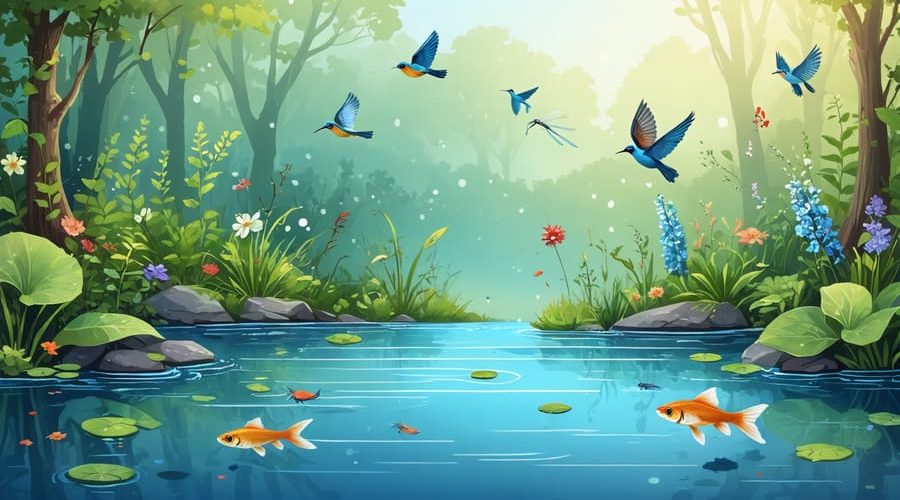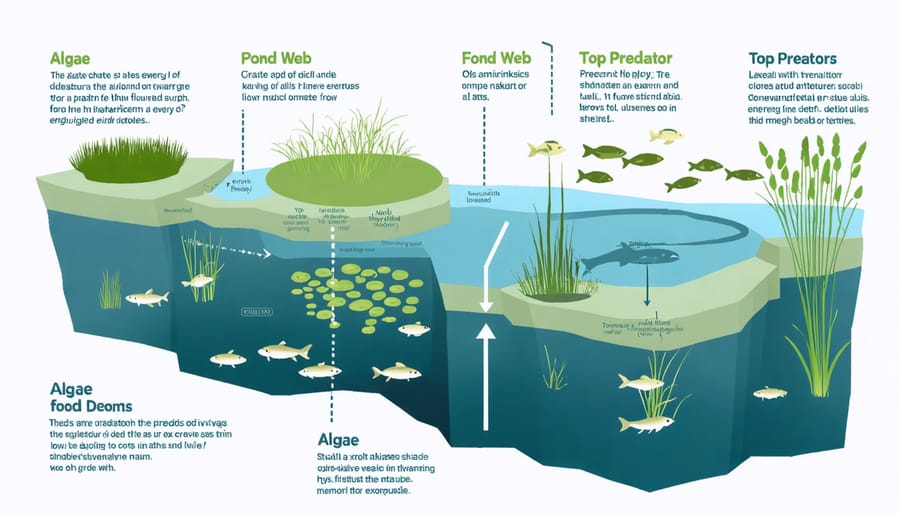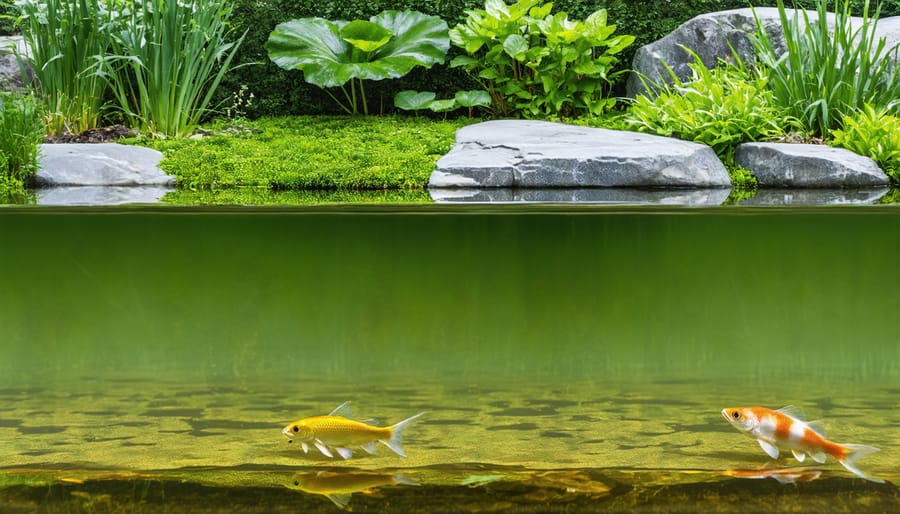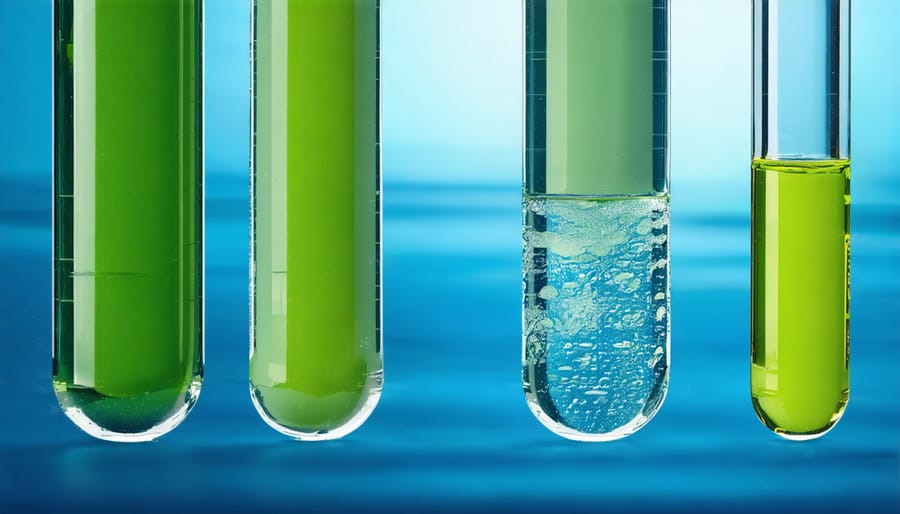
Perfect Your Pond’s Food Web: How to Create a Thriving Aquatic Ecosystem
Dive into the fascinating world of backyard pond ecosystem food webs, where every creature plays a vital role in maintaining nature’s perfect balance. From microscopic algae to darting fish and graceful water birds, these interconnected relationships create a thriving underwater community that’s both beautiful and essential. Understanding aquatic food webs isn’t just about observing nature—it’s your key to creating and maintaining a healthy, self-sustaining water garden that brings life and vibrancy to your outdoor space.
Picture your pond as a living theater, where tiny water fleas feed on floating algae, while small fish dart after insects, and larger predators maintain population balance. Each level of this underwater food chain contributes to water clarity, pest control, and overall ecosystem health. Whether you’re starting your first water garden or enhancing an existing pond, grasping these natural relationships helps you make smarter choices about plant selection, fish stocking, and maintenance routines.
Understanding Your Pond’s Food Web

Primary Producers: The Foundation
At the heart of every pond’s food web are the primary producers – nature’s master chefs who turn sunlight into food. Algae and aquatic plants are the true heroes here, using photosynthesis to create the energy that powers the entire ecosystem. Think of them as your pond’s solar panels!
In a healthy pond, you’ll find different types of these primary producers working together. Floating plants like duckweed and water lilies shade the surface, while submerged plants like hornwort and anacharis thrive below. Even those sometimes-pesky string algae play a crucial role by producing oxygen and food for small creatures.
These plants don’t just make food – they’re also excellent natural filters, removing excess nutrients from the water and helping keep your pond clear. Plus, they provide essential hiding spots for small fish and other pond creatures. When you’re planning your pond, aim for a good mix of different plant types. This diversity ensures your pond’s food web has a strong foundation, just like a well-stocked kitchen ready to feed a hungry family.
Remember, a thriving community of primary producers means a healthier, more balanced pond ecosystem overall.
Consumers: From Tiny to Large
In every pond, there’s a fascinating hierarchy of consumers, each playing their part in the ecosystem’s balance. At the tiniest level, microscopic zooplankton feed on algae and bacteria, acting as nature’s cleanup crew. These little dynamos help keep your pond water clear while serving as food for larger creatures.
Moving up the size scale, aquatic insects and their larvae create the next exciting layer of predator-prey relationships. Water beetles, dragonfly nymphs, and diving bugs dart through the water, feeding on smaller organisms while avoiding becoming snacks themselves. These insects are essential middle-ground consumers that help regulate populations of both smaller and larger species.
At the top of your pond’s food chain, you’ll find fish and amphibians. From small minnows to larger koi, these creatures feed on everything from insects to plant matter. Some fish, like bass or perch, are particularly helpful in controlling insect populations. The beauty of this system is that each consumer level helps keep the others in check, creating a self-sustaining ecosystem that brings life and vibrancy to your water garden.
Building a Balanced Food Web

Selecting the Right Plants
When creating a balanced aquatic food web, choosing the right plants is crucial for your pond’s success. Start by incorporating a mix of native aquatic plants that serve different purposes in your ecosystem. Include submerged plants like hornwort or waterweed, which oxygenate the water and provide shelter for small aquatic creatures.
Floating plants such as water lilies and lotus not only add beauty but also provide essential shade and protection for fish. Aim to cover about 60% of your pond’s surface with floating vegetation, being careful not to overcrowd the water. Along the edges, plant emergent species like cattails and rushes, which help filter water and create natural transitions between water and land.
Consider your climate zone and pond depth when selecting plants. Some species thrive in shallow waters, while others need deeper areas to establish strong root systems. Start with hardy varieties that are known to do well in your region, and gradually introduce more delicate species as you gain experience.
Remember to avoid invasive species that can take over your pond and disturb the natural balance. Your local garden center or aquatic specialist can help identify which plants are safe and suitable for your area. By choosing a diverse range of plants that fulfill different roles, you’ll create a strong foundation for your aquatic food web.
Introducing Beneficial Microorganisms
Getting your pond’s ecosystem started begins with introducing beneficial microorganisms that form the foundation of a healthy aquatic food web. Start by adding a handful of sediment from an established pond, which contains naturally occurring bacteria and microbes. If you don’t have access to pond sediment, quality bacterial supplements from your local pond store work great too.
Timing matters when introducing these tiny helpers. Choose a mild day when water temperatures are between 50-75°F (10-24°C). Add your bacterial culture in the morning to give the microorganisms time to establish themselves during daylight hours. Avoid using tap water directly – let it sit for 24 hours first to allow chlorine to dissipate, as this can harm the beneficial bacteria.
To help your microscopic community thrive, add some organic matter like fallen leaves or barley straw. These materials provide food and shelter for the bacteria. Keep your pump running at a gentle flow to ensure good oxygen circulation without disturbing the settling bacteria.
Be patient – it takes about 4-6 weeks for a healthy bacterial colony to establish itself. During this time, avoid adding fish or using any chemical treatments that might disrupt the developing microorganism community. You’ll know you’re on the right track when the water begins to clear naturally and algae growth stabilizes.
Fish Selection and Stocking
When selecting fish for your pond, it’s important to choose species that will contribute to a balanced ecosystem. Start with a mix of different feeding types – surface feeders like golden orfe, mid-water swimmers like goldfish, and bottom feeders like koi. This variety ensures that all layers of your pond are actively maintained.
Consider the size of your pond when stocking fish. A general rule is to allow about 50 gallons of water per inch of adult fish. Overstocking can lead to oxygen depletion and excess waste, which can throw your pond’s food web out of balance.
Native species often make excellent choices as they’re already adapted to your local climate and can support indigenous insects and plants. However, if you’re introducing ornamental fish, make sure they’re compatible with your region’s temperature range and won’t outcompete existing species.
Start with a small number of fish and gradually increase the population. This allows the beneficial bacteria and plant life to establish and adjust to the bioload. When introducing new fish, quarantine them for at least two weeks to prevent the spread of diseases to your existing population.
Remember that fish are both predators and prey in your pond’s food web. Some species, like mosquito fish, help control insect populations, while others may feed on aquatic plants or smaller fish. Choose a combination that creates a sustainable balance for your specific pond environment.
Maintaining Food Web Health
Water Quality Management
Maintaining optimal water quality is crucial for a thriving aquatic food web. Start with regular testing of key parameters like pH, ammonia, nitrites, and dissolved oxygen levels. Most pond life thrives in a pH range between 6.5 and 8.5, while ammonia and nitrites should be as close to zero as possible.
Installing a reliable filtration system is your first line of defense against poor water quality. Combine mechanical filtration to remove debris with biological filtration to break down harmful compounds. Adding beneficial bacteria monthly helps maintain the nitrogen cycle and keeps your water crystal clear.
Proper aeration is essential for all levels of the food web. Surface agitation and deep-water aeration ensure oxygen reaches every layer of your pond. This is particularly important during warm summer months when oxygen levels naturally decrease.
Plants play a vital role in water quality management. Include a mix of submerged, floating, and marginal plants that absorb excess nutrients and provide shelter for various organisms. Aim to cover about 60% of your pond’s surface with vegetation.
Regular maintenance prevents problems before they start. Remove dead plant material promptly, clean filters as needed, and perform partial water changes (about 10-15%) monthly. During spring and fall, deep cleaning helps reset the system and prepare for seasonal changes.
Monitor water clarity and watch for warning signs like unusual algae growth or fish gasping at the surface. Quick response to water quality issues helps maintain the delicate balance of your aquatic food web and ensures all organisms from microscopic algae to top predators can thrive in their environment.

Seasonal Adjustments
Just like nature itself, your pond’s food web needs different care as the seasons change. In spring, as temperatures warm up, start by gradually increasing feeding rates for your fish as they become more active. This is also the perfect time to add new plants and beneficial bacteria to jumpstart your pond’s ecosystem after winter.
Summer brings peak activity in your pond’s food web. Keep an eye on water temperatures, as warmer water holds less oxygen. Consider adding a fountain or aerator to maintain healthy oxygen levels. Feed your fish regularly but avoid overfeeding, which can lead to algae problems. Trim back excessive plant growth to maintain balance.
As autumn approaches, begin reducing fish feeding as their metabolism slows down. Remove falling leaves before they sink and decay, which can upset your pond’s nutrient balance. This is also a great time to thin out plants and remove any dead vegetation that could decompose over winter.
Winter requires the most significant adjustments. Stop feeding fish when water temperatures drop below 50°F (10°C), as they enter a period of dormancy. Remove any remaining dead plant material and consider using a pond net to prevent leaves from falling in. If you live in a cold climate, keep a small area free of ice to allow gas exchange, but avoid breaking the ice as this can stress your fish.
Remember that these seasonal changes aren’t just about maintenance – they’re about supporting your pond’s natural rhythms and ensuring your aquatic food web stays healthy year-round.
Common Problems and Solutions
Signs of Imbalance
A healthy pond should be teeming with life, so when things start going wrong, nature usually sends clear signals. Watch out for unusually cloudy or green water, which often indicates an algae bloom caused by excess nutrients. If you notice dead fish floating on the surface or fish gasping for air near the top, your pond’s oxygen levels might be critically low.
Keep an eye on your plant life too. When underwater plants become covered in thick algae or start dying off mysteriously, it’s a sign that your food web needs attention. An overabundance of one species, like too many tadpoles or a sudden explosion of mosquito larvae, suggests that your predator-prey relationships are out of balance.
Foul odors are another red flag – a healthy pond should smell fresh and earthy, not like rotten eggs. Also notice if previously active wildlife, such as dragonflies or frogs, suddenly disappear from your pond. Regular visitors stopping their visits often means something’s amiss in your aquatic ecosystem.
The good news is that most imbalances can be corrected once spotted early. Getting to know your pond’s normal state makes it easier to spot these warning signs before they become serious problems.
Corrective Actions
When you notice signs of an imbalanced aquatic food web, quick action can prevent bigger problems. Start by testing your water quality regularly, especially pH and oxygen levels. If you spot algae overgrowth, introduce more floating plants to compete for nutrients and add natural barley straw extracts to help control it.
For an undersized fish population, gradually introduce new compatible species, starting with smaller fish that won’t overwhelm the system. If you have too many predators, consider relocating some to maintain balance. Adding structures like rocks and submerged logs creates hiding spots for smaller creatures and helps maintain biodiversity.
When invertebrate populations are low, reduce fish feeding temporarily to encourage natural foraging. You can also add beneficial insects and crustaceans from reputable suppliers. If you notice declining plant life, check your water depth and sunlight exposure, adjusting as needed.
Remember to make changes slowly and observe the results. Quick fixes often lead to more problems, so patience is key when correcting food web issues.
Understanding and maintaining a healthy aquatic food web is essential for creating a thriving pond ecosystem. By ensuring a balanced mix of producers, consumers, and decomposers, you can create a self-sustaining environment that requires minimal intervention. Remember to start with strong plant foundations, introduce appropriate fish species gradually, and monitor water quality regularly. Consider adding beneficial insects and native species to enhance biodiversity. Your pond’s food web is a delicate dance of life that rewards patience and careful observation. Take the first step today by assessing your current pond setup or planning your new water feature with these principles in mind. With proper care and attention to these natural relationships, you’ll create a beautiful and sustainable aquatic ecosystem that brings joy for years to come.
